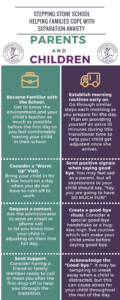Helping Families Cope with Separation Anxiety
For many parents, it is the most challenging part of the decision to go back to work after having a child: the idea of leaving your child in the care of another. This feeling of separation can be emotionally challenging for both parent and child alike. At Stepping Stone School, the initial separation of the child from their parent(s) is of utmost importance. Rhonda Paver, M.A., founder and executive director wrote her master’s thesis on this topic and we continue to provide the smoothest transitions for families possible since our inception.
Helping Parents Cope with Separation Anxiety
Parents may feel upset at separating from their child because of their child’s reaction, their own feelings, or a combination of both. There are several proactive measures parents can take to support a more positive experience:
- Become Familiar with your care provider. Get to know the school environment and your child’s teacher as much as possible, before the first day so you feel comfortable leaving your child in that setting. At Stepping Stone School, families are welcome to visit the classroom at any time.
- Consider a “Warm Up” Visit. Bring your child in for a few hours on a day when you do not have to rush off to work. Provide your child with the opportunity to meet some of the other children, meet the teacher, and play with the toys in the classroom. Stepping Stone School highly encourages an initial visit prior to your child’s first day.
- Request a contact. Ask the administrator to send an email or phone call to inform you as to how your child is adjusting that first full day. This simple reassurance may make all the difference in helping you adjust to the change in routine. At Stepping Stone School, we provide daily electronic pictures, videos and reports for every child. Stepping Stone School also has color video cameras in most classrooms for easy parent viewing on a monitor near the front entry. This allows a parent to watch their child’s transition to ensure their child is welcomed into the classroom and readily joins in group activities. You might be pleasantly surprised to find that your child is excited and happy to be with their peers and may not experience separation anxiety at all!
- Seek Support. Consider having a friend or family member ready to call or meet you right after the first drop-off to help you through the transition.
Helping Children Cope with Separation Anxiety
Between six to seven months old, a child becomes much more aware of the people around her. This development in her cognitive abilities helps her to recognize when she is in a new place with people she does not know versus being in a familiar place with people she does know. This ability, as amazing as it is, can cause her to feel anxious, but there are steps parents can take to help her cope with separation:
- Establish morning routines early on. Go through similar steps each morning as you prepare for the day. Plan on providing yourself an extra 10 minutes during this transitional time to help your child get adjusted once she arrives. Even if your child transitions well, everyone will feel more settled by not being so rushed.
- Send positive signals when saying good-bye. You may feel sad as a parent, but all expressions to your child should say, “Yay, you are going to have SO MUCH FUN!” Your child will get many of her cues for how to respond to the situation from the way you are acting.
- Create a good-bye ritual. Consider a special good-bye handshake or a hug-kiss-high-five routine which will make your child smile before saying good-bye. Practice this ritual with your child prior to the first day of dropping-off.
- Acknowledge the “Good-bye.” It may be tempting to sneak away when a child is distracted, but this can cause stress for your child throughout the rest of the day. Acknowledging the good-bye and letting her know you will return builds trust.
If handled well, these separations can become a positive learning experience, an opportunity supporting independence and resilience in your child.

Resources:
Hurley, K. (2015, Sep.). Helping Preschoolers Cope with Separation Anxiety. Retrieved from http://www.pbs.org/parents/expert-tips-advice/2015/09/helping-preschoolers-cope-separation-anxiety/
McCracken, J. (1997). So Many Goodbyes: Ways to Ease the Transition Between Home and Groups for Young Children. National Association for the Education of Young Children. ASIN: B0006RRI16
Paver, R.G. (1987). The Relationship Between Maternal Separation Anxiety, Caregiver Characteristics, and Children’s Behavior in the Day Care Setting (Master’s Thesis). The University of Texas at Austin, Austin, TX.
Stonehouse, A. (2008). How Does It Feel? Child Care from Families’ Perspectives. Redmond, WA: Exchange Press.
Stonehouse, A. (2009, Dec.). Positive goodbyes: Helping children and families to manage separations. Putting Children First, 10-12. Retrieved from http://ncac.acecqa.gov.au/educator-resources/pcf-articles/Positive_goodbyes_Dec09.pdf